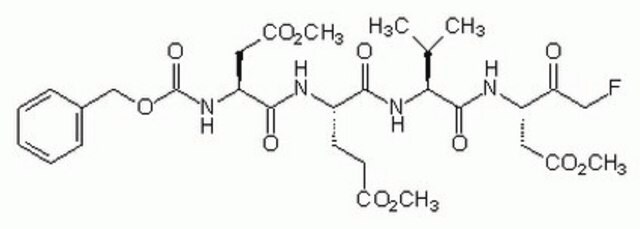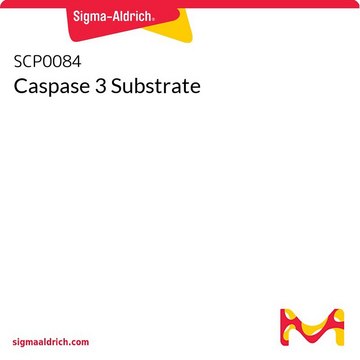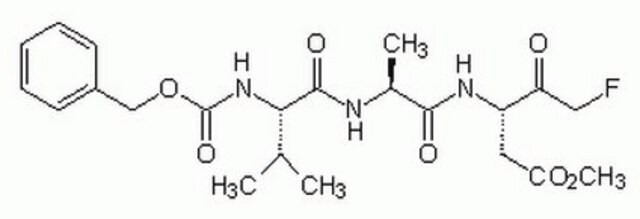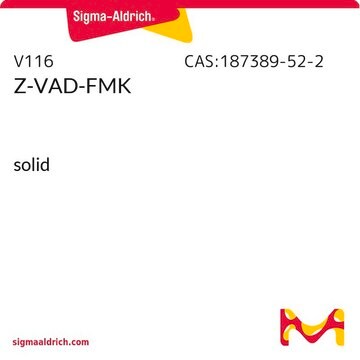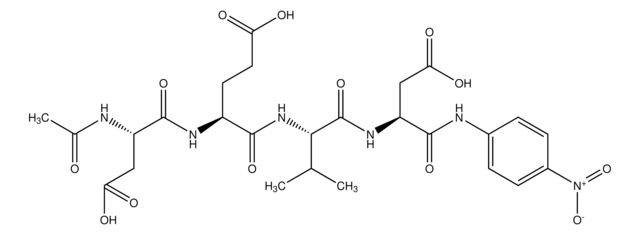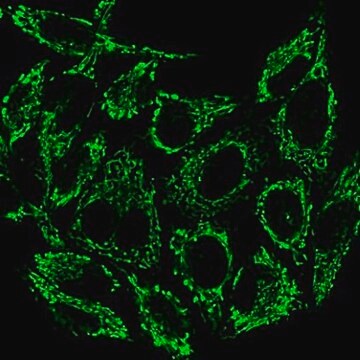235400
Caspase-3 Substrate I, Colorimetric
Colorimetric substrate for caspase-3 (Km = 9.7 µM) and related cysteine proteases.
Synonim(y):
Ac-DEVD- pNA
Zaloguj sięWyświetlanie cen organizacyjnych i kontraktowych
About This Item
Wzór empiryczny (zapis Hilla):
C26H34N6O13
Numer CAS:
Masa cząsteczkowa:
638.58
Kod UNSPSC:
12352200
Polecane produkty
Próba
≥95% (HPLC)
Formularz
lyophilized
producent / nazwa handlowa
Calbiochem®
warunki przechowywania
OK to freeze
desiccated
protect from light
rozpuszczalność
DMSO: 60 mg/mL
Warunki transportu
ambient
temp. przechowywania
−20°C
Opis ogólny
Colorimetric substrate for CPP32/Apopain/Yama (Km = 9.7 µM) and related cysteine proteases. Sequence is based on the P1-P4 tetrapeptide cleavage site of poly (ADP-ribose) polymerase (PARP) and includes Asp216. CPP32 is the protease responsible for the cleavage of PARP. Can be used with Pro-caspase-3 in in vitro assays to measure caspase-9 activity, since caspase-9 activates pro-caspase-3. Cleavage of the substrate can be monitored at 405 nm (ε = 9160 cm-1M-1).
Colorimetric substrate for caspase-3 (Km = 9.7 µM) and related cysteine proteases. Sequence is based on the P1-P4 tetrapeptide cleavage site of poly(ADP-ribose) polymerase (PARP) and includes Asp216. Caspase-3 is the protease responsible for the cleavage of PARP. Also a substrate for caspase-6, caspase-7, caspase-8, and caspase-10. Cleavage of pNA is monitored colorimetrically at ~405 nm.
Działania biochem./fizjol.
Cell permeable: no
Km = 9.7 µM as colorimetric substrate for caspase-3
Primary Target
Caspas-3
Caspas-3
Product does not compete with ATP.
Reversible: no
Ostrzeżenie
Toxicity: Standard Handling (A)
Sekwencja
Ac-Asp-Glu-Val-Asp-pNA
Rekonstytucja
Following reconstitution, aliquot and freeze (-20°C). Stock solutions are stable for up to 6 months at -20°C.
Inne uwagi
Cardone, M.H., et al. 1998. Science 282, 1318.
Thornberry, N.A., and Lazebnik, Y. 1998. Science 281, 1312.
Nicholson, D.W., et al. 1995. Nature376, 37.
Lazebnik, Y.A., et al. 1994. Nature371, 346.
Thornberry, N.A., and Lazebnik, Y. 1998. Science 281, 1312.
Nicholson, D.W., et al. 1995. Nature376, 37.
Lazebnik, Y.A., et al. 1994. Nature371, 346.
Informacje prawne
CALBIOCHEM is a registered trademark of Merck KGaA, Darmstadt, Germany
Ta strona może zawierać tekst przetłumaczony maszynowo.
Kod klasy składowania
11 - Combustible Solids
Klasa zagrożenia wodnego (WGK)
WGK 1
Temperatura zapłonu (°F)
Not applicable
Temperatura zapłonu (°C)
Not applicable
Certyfikaty analizy (CoA)
Poszukaj Certyfikaty analizy (CoA), wpisując numer partii/serii produktów. Numery serii i partii można znaleźć na etykiecie produktu po słowach „seria” lub „partia”.
Masz już ten produkt?
Dokumenty związane z niedawno zakupionymi produktami zostały zamieszczone w Bibliotece dokumentów.
Konrad A Szychowski et al.
Pesticide biochemistry and physiology, 168, 104638-104638 (2020-07-28)
Triclosan (TCS) is commonly used worldwide in a range of personal care and sanitizing products. A number of studies have revealed the presence of TCS in human tissues. It has recently been shown that TCS can interact with AhR in
Nasz zespół naukowców ma doświadczenie we wszystkich obszarach badań, w tym w naukach przyrodniczych, materiałoznawstwie, syntezie chemicznej, chromatografii, analityce i wielu innych dziedzinach.
Skontaktuj się z zespołem ds. pomocy technicznej